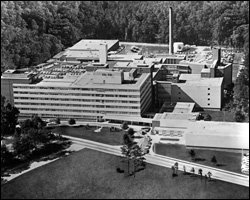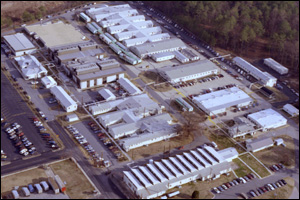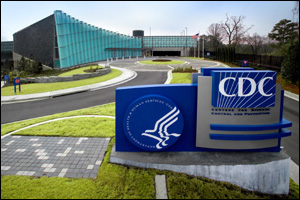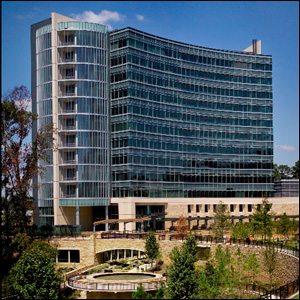CDC In the News
Master Plan and Laboratory Safety Helps CDC Keep Pace with Expanding Public Health Challenges.
Published: June 29, 2007

This 1966 aerial photograph captured the appearance of CDC's headquarters in Atlanta, Georgia as it looked at that time.
CDC Building and Facilities Plan 2000
- Watch the video
 Windows Media, 9.7 MB
Windows Media, 9.7 MB
Running time: 4 minutes, 7 seconds - View a transcript of the video
 PDF, 15 KB
PDF, 15 KB
From its inception in 1946 to the present, CDC has saved lives and improved the health and welfare of people around the world in countless ways. The 21st century brings fresh challenges to those who provide the nation's and the world's first line of defense against threats to public health. Consider, in the last 25 years, CDC participated in the discovery of more than 30 new infectious diseases and agents like ebola hemorrhagic fever and Legionnaire's disease.
The men and women of CDC are ready to face these challenges but while the boundaries and burdens of public health defense continued to expand exponentially, CDC facilities were not keeping pace. In the more than 60 years that CDC has been working to ensure public health, very little by way of buildings and facilities had changed. At the Chamblee Campus, for instance, the first laboratories were housed in converted Army barracks, and these pre-World War II structures, which were meant to last 10 to 15 years, were still in use at the start of the new millennium. Inside the buildings conditions were even more alarming. Corridors were packed with freezers containing pathogenic agents and bio-hazardous substances because there just wasn't enough room in the lab support areas. Likewise, filing cabinets full of documents, storage shelves and other items were lodged awkwardly in public hallways. Rooms that should house only one or two workers contained four, five and more. Old bathrooms were even pressed into service packed with laboratory equipment and supplies.
Critical systems were also in a shocking state of decline. Outdated electrical systems strained under the never ending load of added machinery and equipment. Duct work was deteriorating and lab workers were forced to devise makeshift methods to minimize particles and debris blowing directly onto sensitive equipment and compromising test results. Rainwater had to be diverted away from expensive lab equipment sitting beneath the leaking ceilings. In most CDC buildings, laboratory and office work was done in a single large room where directional airflow could not be controlled and hazardous work could not be compartmentalized. Such conditions severely threaten the functionality, safety and efficiency of these areas.

From an aerial perspective, this 1988 photograph depicted CDC's Chamblee, Georgia campus.
CDC's campuses had suffered from years of neglect—neglect so severe that members of the Atlanta business community and bipartisan members of the Georgia delegation stepped in and helped initiate a rehabilitation plan to ensure that CDC's world class scientists had safe, secure, and state-of-the-science space for their public health work. A master plan to address the problems of buildings and facilities for the purpose of ensuring the health of our nation and nations of the world is guiding the use of available resources. CDC prioritized buildings and facilities funds to replace antiquated, underperforming or poorly-located facilities, mainly laboratories, in accordance with the Master Plan. Importantly, public health program funds are not used for buildings and facilities activities, so there is no tension about prioritizing the funding of a building versus a public health program. Buildings and facilities funds are appropriated by Congress specifically for facilities projects. Since the late 1990's CDC has replaced 26 antiquated facilities, mostly lab buildings, with new safe flexible modern space. The new space meets all applicable regulations and codes for space utilization safety environmental sustainability operations efficiency and physical security.

The exterior of the new "Tom Harkin Global Communications Center", otherwise known as Building 19, located on CDC's Roybal Campus in Atlanta, Georgia. (Photo by James Gathany)
Under the Master Plan to date, CDC has provided safe modern efficient lab and lab support space to all of its Atlanta environmental health scientists. And, with the completion of the Building 23 project in 2010, CDC will also house all of its biological scientists in safe modern efficient lab space. Both of these are original Atlanta Master Plan objectives and which have been completed on budget, scope and schedule.
CDC's new Tom Harkin Global Communications Center, which includes the Visitor Center, provides a venue for scientific training programs for public health professionals, a hub for distance learning, and a place for employees and visitors to study and learn about public health. The existing Visitor Center, with its 15,000 visitors annually, used to be located well into the CDC research campus, adjacent to laboratories. The high definition multi-media screens in the visitor center introduce visitors and students to narrative films about public health activities such as HIV/AIDS and pandemic influenza.
The new Headquarters and Marcus Emergency Operations Center is a flexible and efficient workplace for administrative and operations staff. Energy-saving features incorporated into the building's design and operation include solar shading and screening, energy recovery systems, daylight sensors, air sampling systems, and multiple back-up power systems.

The exterior of the new "Arlen Specter Headquarters and Emergency Operations Center", otherwise known as Building 21, located on CDC's Roybal campus in Atlanta, Georgia. (Photo by James Gathany)
CDC has accomplished most of the Master Plan projects using an innovative contracting structure that saved from one-half to two-thirds of traditional acquisition time. This resulted in time and money savings. In addition, CDC has incorporated "Green and Sustainable" elements into its Master Plan design and construction activities. For example the new Emergency Operations and Headquarters facilities achieved a Silver LEED™ rating—recognized in the industry as demonstrating environmental stewardship.
CDC's $1.5 billion 10-year master plan involving renovation and reconstruction of the Chamblee and Roybal campuses have provided CDC with safe, secure, modern and cost efficient facilities enabling the agency to better protect the nation's health and safety. The investments made in CDC's facilities have led to scientific advances in terrorism response, pandemic influenza, and many other public health threats, increased its ability to communicate with health departments and healthcare providers around the world, and strengthened its ability to respond to public health emergencies.
Update Building 18

Construction of Building 18 was completed in 2005 and people began moving in almost immediately. The commissioning process for the maximum containment laboratories, the work needed to bring the complex research laboratories on-line, is now nearing completion. CDC’s lab work is critical to our ability to protect people’s health and we realize the importance of using our new resources as promptly as possible. More importantly, we recognize the need to ensure our new laboratories, the most modern in the world, have the capabilities needed to do our leading edge science and that they meet the highest safety standards.
Commissioning is a multi-step process which began when the building construction was completed and is similar to a technical “test drive” of the building done before occupancy. Currently, BSL2 and BSL3 laboratories are operational and more than 500 people are working in the building. We are completing rigorous checks and rechecks of the BSL4 facilities to assure that all systems for handling air and waste materials are completely reliable and redundant. Our superb safety record is a result of making the protection of our scientists and surrounding communities a top priority.
A power surge a few weeks ago has fostered questions about the new building’s systems. The power surge, believed to be the result of a lightning strike, caused a localized power outage in the Building 18 laboratories. Since the problem was localized and did not affect power entering the campus, the back-up generators did not activate. If power to the entire campus had been lost, the generators would have activated. The power outage lasted for about 60 minutes before the incident was fully investigated and power was restored.
This incident posed no threat to workers in the building or to the community. The maximum containment labs, or BSL4 labs, in this building were not yet operational. Even if they had been active, multiple safety systems are in place to prevent the release of any dangerous agent. These systems operate even with the loss of power to the building. High efficiency filtration of air entering and leaving the space, specialized seals around doors, and other building designs features all work together to protect our people and the environment during planned and unplanned occurrences in the laboratories. The system is specifically designed with these and many other redundancies and backups, and represents the state-of-the-science in capability, safety, and environmental responsibility.
CDC's lab work is critical to our ability to meet this mission. We
hold ourselves to the highest standards of safety in order to protect
our scientists and our community.
Content source: Centers for Disease Control and Prevention

